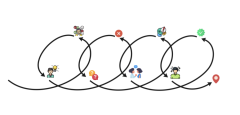I am surprised that Patricia replied to my email again and recommended me three artists:
‘Dan Kelly is an artist who is also a hairdresser. He runs DKUK hair salon and art gallery in Peckham. ‘ https://dkuk.biz/
‘Katrine Bohm started a beverage company called Company Drinks — which is also an artwork.’Patricia said.
‘Tom Ellis is a painter. When he was starting out he used to support himself by making furniture. And then he started to show his furniture with his paintings. His furniture is now considered as sculpture and is an important part of his practice.’Patricia said.
Tom’s combination of painting and furniture activates a striking duality. ‘The fact that they are object types of such a different order allows me to move freely between ostensibly art and non-art activities,’ he says. ‘The furniture serves in part to “depressurise” the painting practice by creating a more culturally blurred setting for its display – a painting above a sofa is a very different proposition to a painting isolated on a pristine gallery wall.’ Tom says he feels that The Wallace Collection brings art closer to the ‘unruly multiplicity of real life, and here we have life in all of its wild and wonderful facets. (Nast, 2016)

Nast, C. (2016). Art: Tom Ellis. [online] House & Garden. Available at: https://www.houseandgarden.co.uk/article/tom-ellis [Accessed 17 Oct. 2021].
